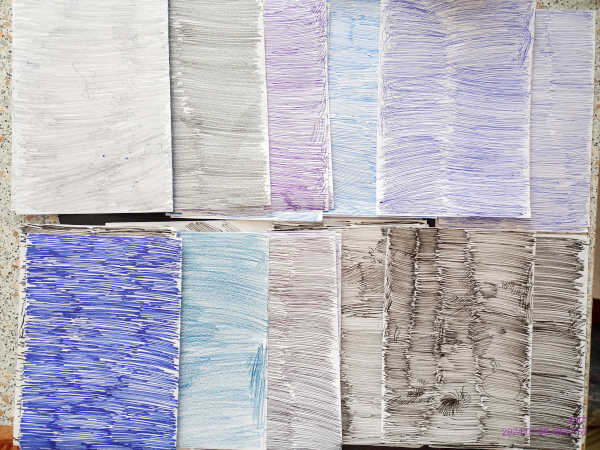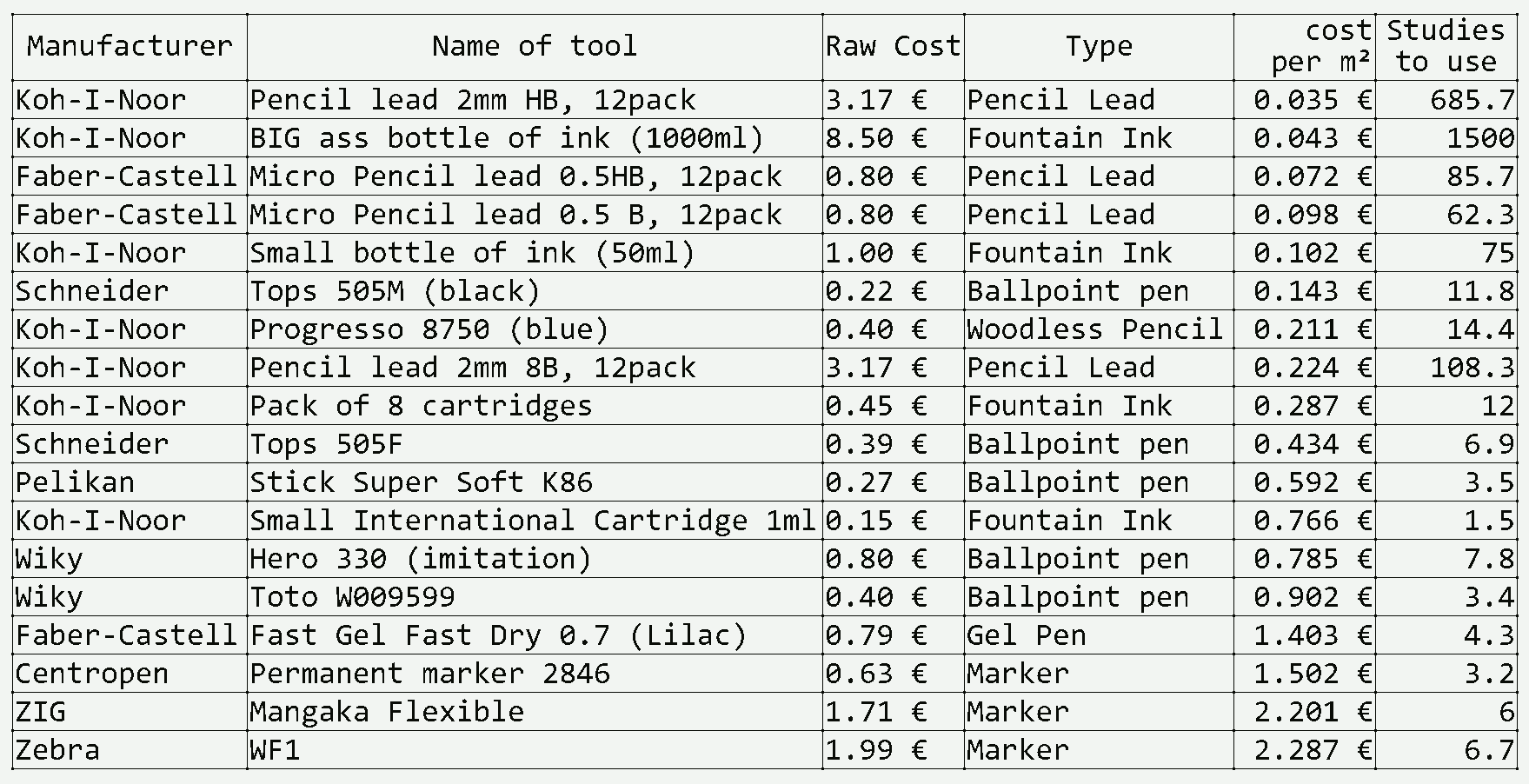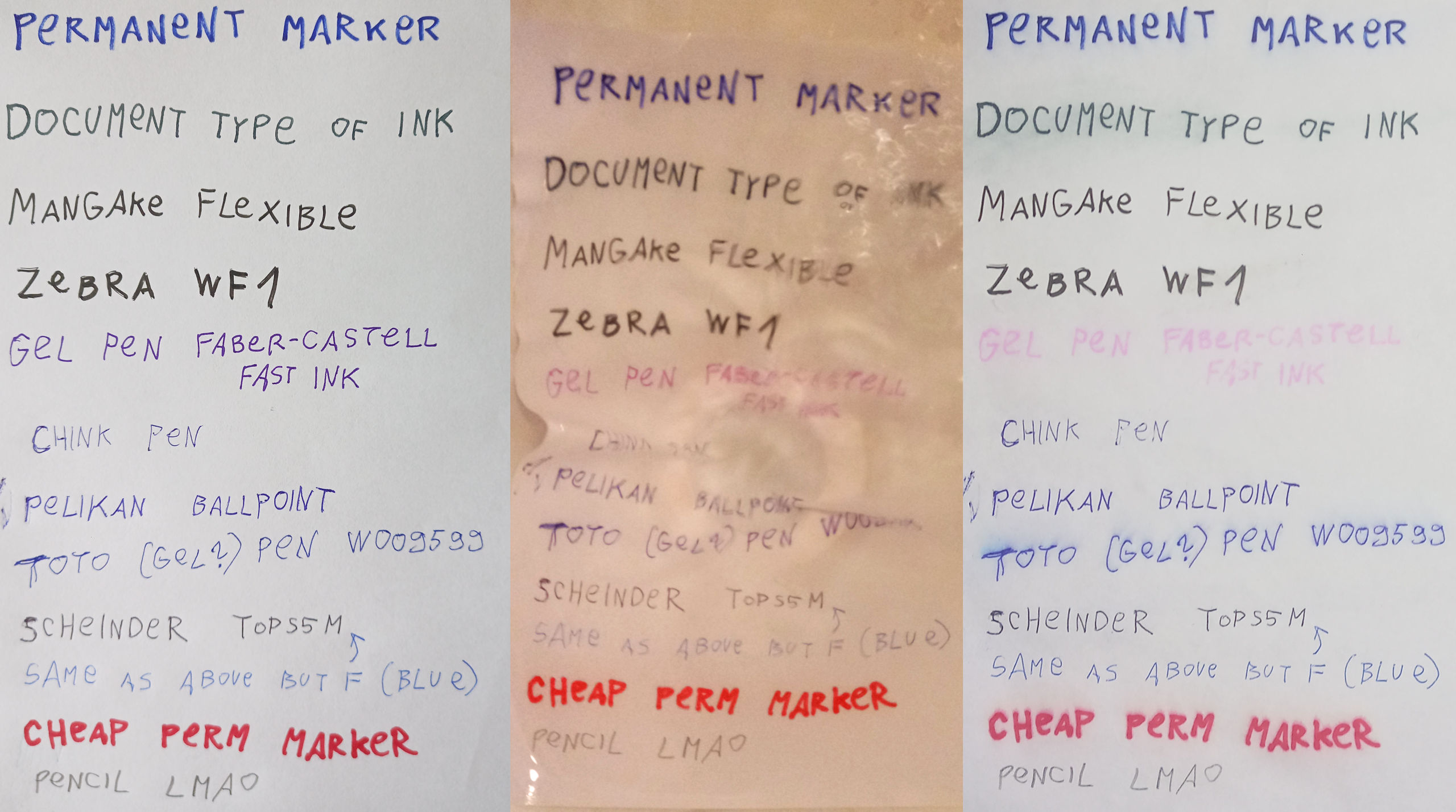Analyzing Cost Efficiency for Drawing Tools
Shortly after setting a goal to transition half of my studies to traditional media, the question arose: which drawing tool provides the best return on investment? Is it the disposable ballpoint pen, pencil, or ink? Conducting a cost analysis is the only way to determine the most cost-effective option.
Tool Selection for Cost Optimization
In selecting drawing tools for our project, I have focused on choosing the most cost-effective options available. This includes using pencils, ballpoints, markers, and fountain pens that are the cheapest in their respective categories. The rationale behind this decision is simple: we seek to maximize quality while minimizing cost.
While some may argue that a 10€ pen feels superior to a 1€ pen, the fact remains that both pens contain the same amount of ink due to their physical limitations. It is important to recognize that manufacturers are driven by the desire to minimize production costs and increase frequency of replacement purchases. By selecting the most affordable tools, we can effectively manage our resources and optimize our overall project costs.
The Brands
The selection of brands is a crucial factor in optimizing resource costs. In the Czech Republic, the main producers of office supplies are Koh-I-Noor and Centropen, while in Germany, it is Schneider and Faber-Castell. The competition in the market keeps margins low, making it cost-effective for customers to purchase local brands. Shipping supplies from countries like the USA(Paper Mate), China, or Japan(Pilot) are not competitive due to higher costs. However, living near these countries may influence your brand preferences. This guide will assess the efficiency of various tools in comparison to each other with regards to current location: central Europe.
Exotic and advanced tools, such as painting supplies and watercolors, are more expensive and are typically used for creating high-quality work. Cost should not be a primary concern when using these tools, as they serve a different purpose compared to basic tools. Comparing them to basic tools would be like comparing a racing car to an army combat vehicle – they are in different classes altogether.
The testing method
In order to optimize resource costs, a practical test was conducted using a tool to evenly fill sheets of A5 copy paper, which was selected due to its affordability and widespread availability. The lines were drawn with a balance of pressure to mimic writing. The varying thickness of pens was noted as a potential concern, as thicker pens use more ink but require fewer strokes to fill the paper evenly. Despite this, the test was deemed fair in terms of resource allocation.
For pens and pencils, the extrapolation technique was utilized to optimize resource costs. By measuring the height of ink in the cylinder tube before and after use, it was possible to determine the rate of ink usage. Assuming a linear consumption rate, the extrapolation process was straightforward and highly accurate.
One important consideration to keep in mind is that certain pens contain thick oil ink in their cartridges, which may require a day or two for the ink to settle before obtaining accurate measurements. The pen that exhibited the longest settling time was the black ballpoint pen from brand Schneider, taking up to 2 days to stabilize. Conversely, other pens typically settled in less than an hour.
Markers that do not utilize traditional ink cartridges were used until completely depleted in order to maximize resource cost efficiency. The marker was deemed finished when it ceased to write without skipping. As a writer or illustrator, the focus should be on the work at hand, rather than struggling with a failing tool.
The results
The findings align with projected cost optimization strategies, with ink and graphite leads proving to be the most cost-effective materials for drawing when purchased in bulk quantities. Surprisingly, disposable ballpoint pens, which are typically inexpensive in bulk sales, did not perform as well as expected in terms of cost efficiency. Despite their initial low cost, their lack of longevity may detract from their overall cost-effectiveness.
Unsurprisingly, markers are the most costly supplies on the market. Despite their desirable features such as variable line thickness and vibrant colors, they deplete quickly and are a significant expense.
Complete Dataset [ODS file, 25KB]
According to our findings, it would take approximately two years to exhaust a pack of HB leads and a remarkable four years to deplete a liter bottle of ink based on current drawing rates.
Pencil vs Mechanical Pencil
When considering 2mm leads, there is no significant cost difference between purchasing pencils or spare pencil leads. However, in cases where a deal offers 12 pencils at a lower cost than a pack of 12 spare pencil leads, opting for pencils may be more economical. On average, however, pencil leads tend to be the more cost-effective option.
It is important to note that micro pencils cannot be directly compared to regular pencils, as they serve different purposes and have unique qualities in terms of writing or drawing styles. Ultimately, the choice between the two will depend on individual preferences and specific usage requirements.
Soft vs Hard Pencil lead
The utilization of resources in terms of pencil types shows that the HB pencil can last 37% longer than the B pencil and an impressive 630% longer than the 8B pencil. These statistics highlight the significant differences in resource efficiency and cost optimization.
Ballpoint pens
From an economic perspective, the average cost of all ballpoint pens across brands and types is relatively similar. However, there are notable differences in user experience. Some pens may emit unpleasant odors, produce excessive ink blobs that can smudge on paper, or scratch the surface when writing. To ensure optimal performance when using ballpoint pens as a primary tool, it is advisable to purchase and test various brands for usability and quality.
Water Test
The testing of tools against water was not originally planned, however, it was found to be a quick and efficient process. After all utilizing watercolors proved to be the most cost-effective method for transforming sketches into final products with colors. It is crucial for lines to be waterproof in order to ensure the longevity of the finished pieces, especially for those who enjoy drawing in damp conditions or require sketches to be stored underwater.
Based on our analysis, it is evident that the gel pen is the only tool that is not water resistant. After conducting tests to smudge the ink with fingers underwater, it was found that all other tools remained unaffected. Ink types can be categorized into four main categories: water-based (fountain pen, gel pen), oil-based (ballpoints), alcohol-based (permanent marker, copics), and pigment-based (expensive markers and fountain pen inks). Only water-based ink is susceptible to being washed out by water. Naturally all dry media like pencil lead is impervious to water.
There is a special type of water-based ink, such as ISO 14145-2 (equivalent for ballpoint pens is ISO 12757-2), known as Document Ink, that is water-resistant (and other benefical properties like fast drying or acid resistant). These inks, while still soluble in water, undergo a chemical reaction upon contact with cellulose in paper. This reaction results in a permanent change in the paper's structure, making the ink line as permanent as the paper itself.
Conclusion
According to cost optimization analysis, the 2mm mechanical pencil and fountain/rollerball ink pen are the most cost-effective tools that complement each other well for sketching and producing a high-quality finished product. The price competitiveness of these tools far surpasses that of other options, including expensive markers.
In terms of quality and affordability, markers with pigment are recommended for those who value quality over cost. It is advised to avoid ballpoint pens due to their subpar appearance and writing quality. Gel pens offer a comfortable writing experience, similar to markers, making them a viable option for those who seek the middle option in both cost and quality.



